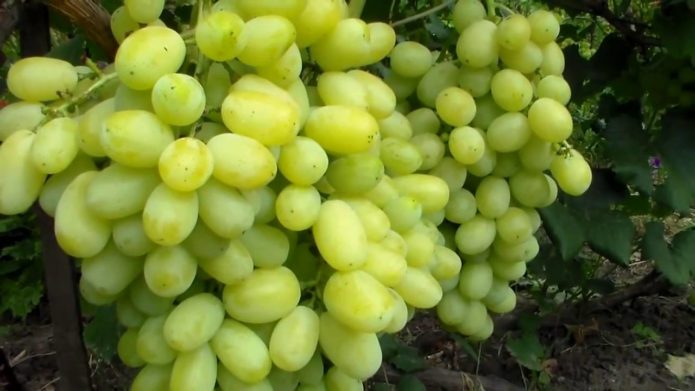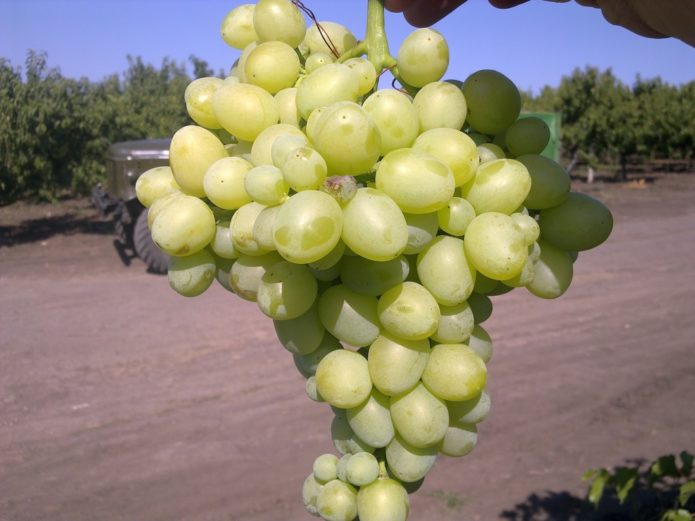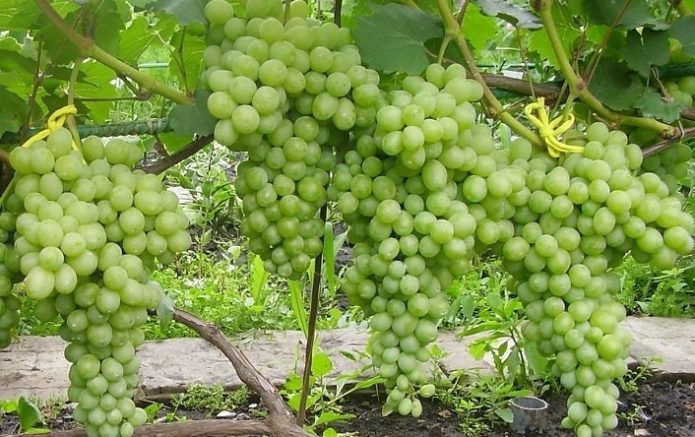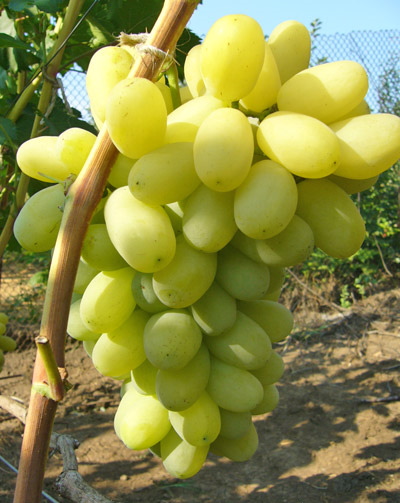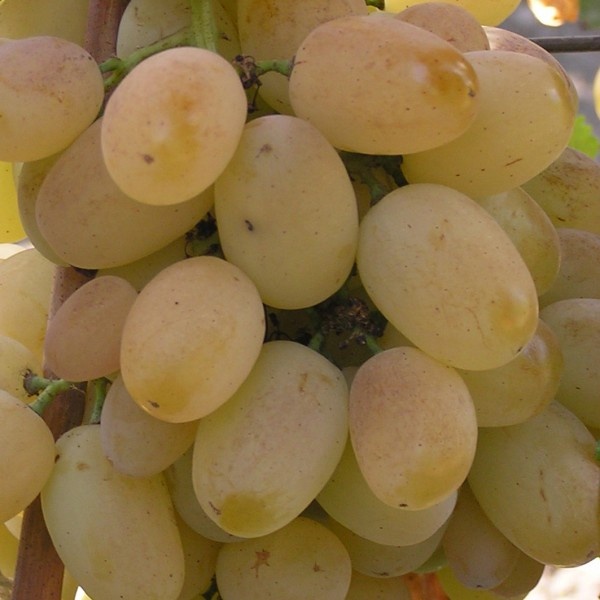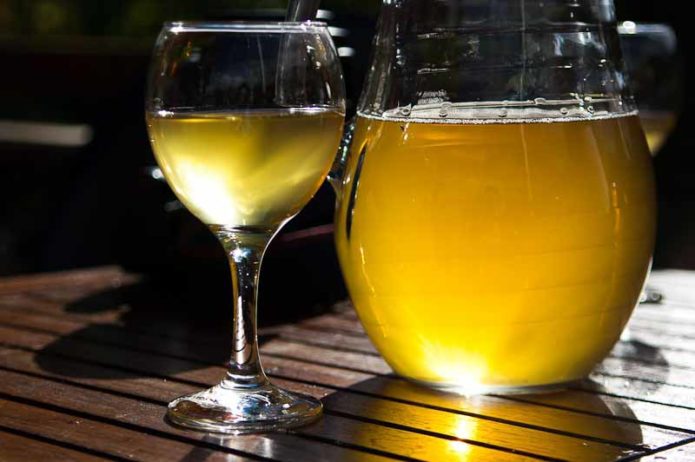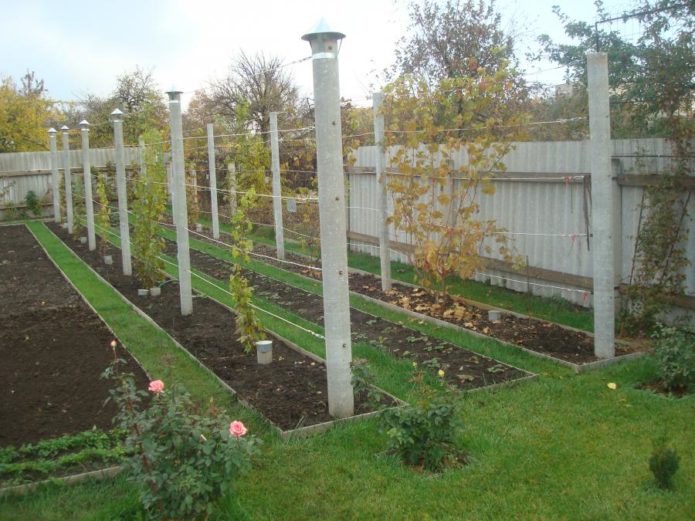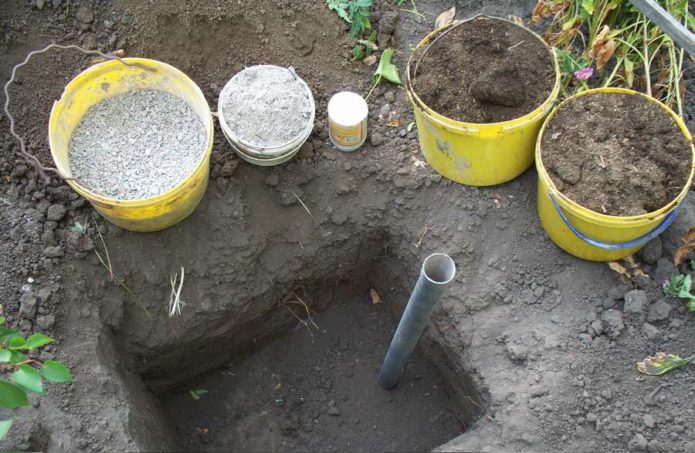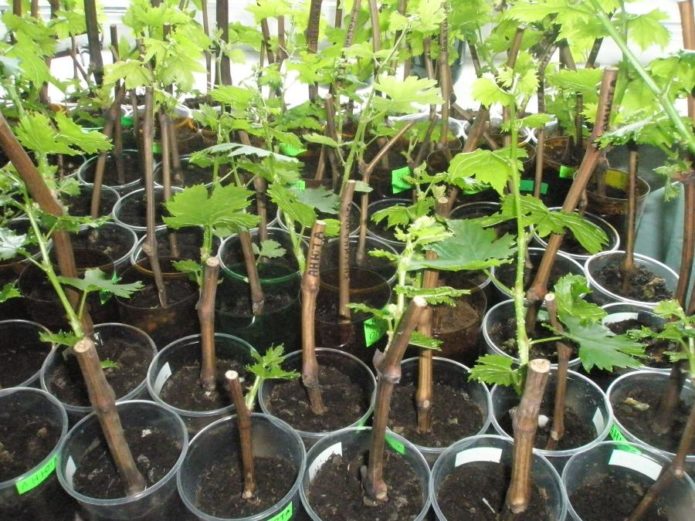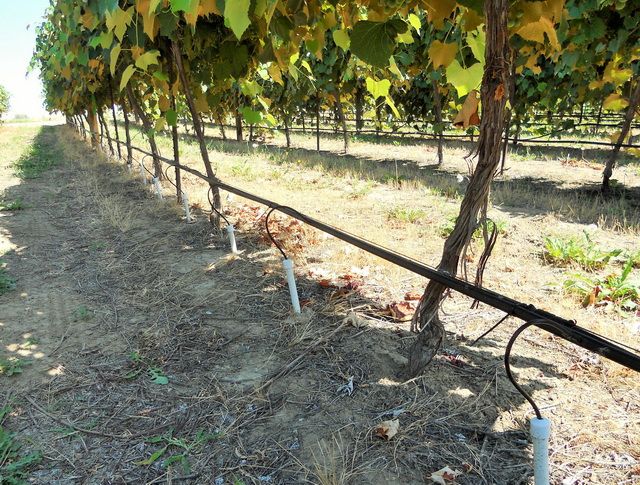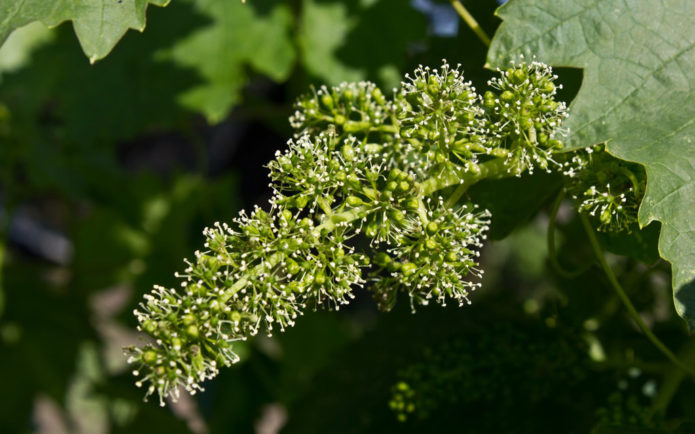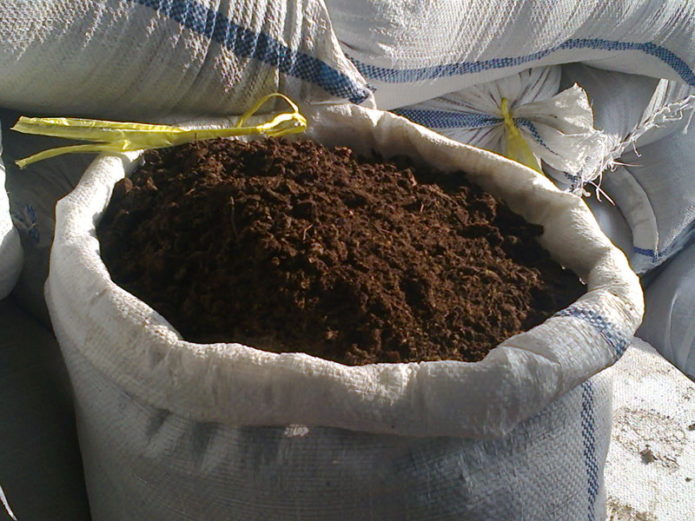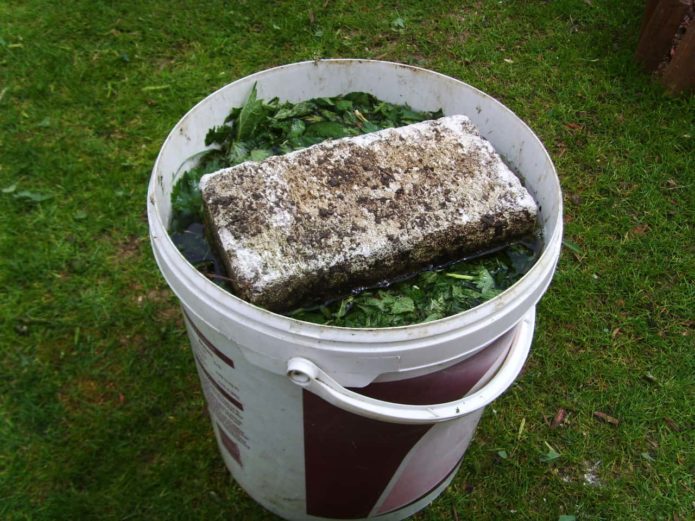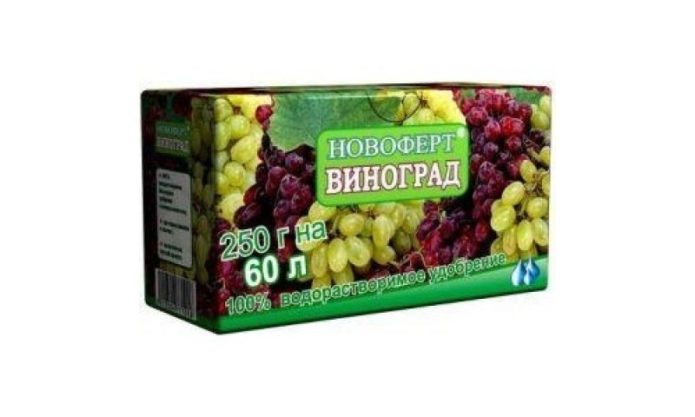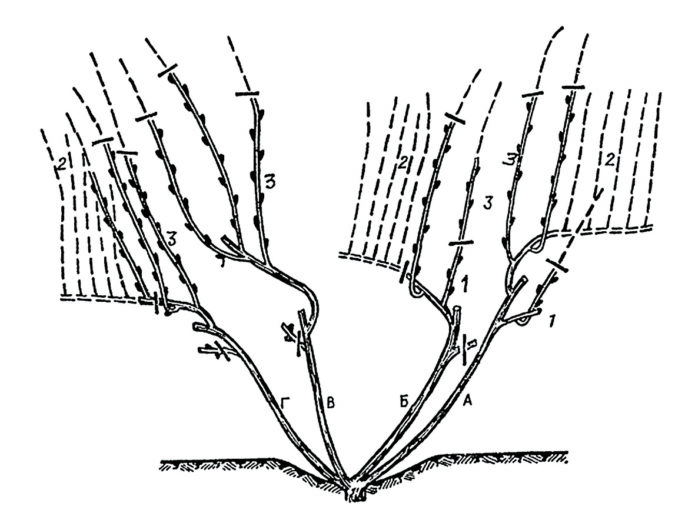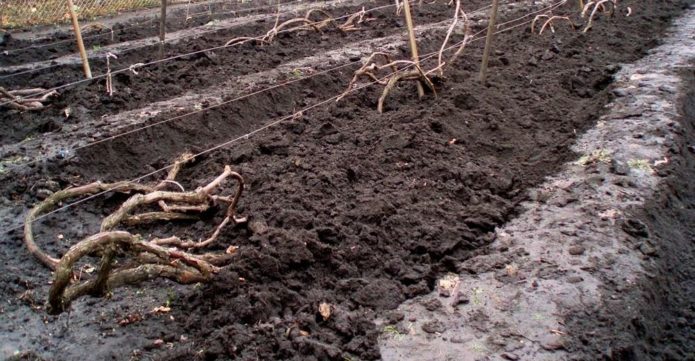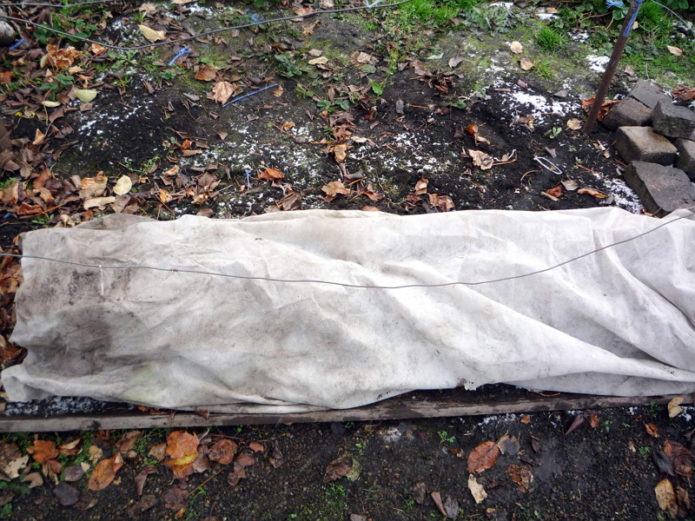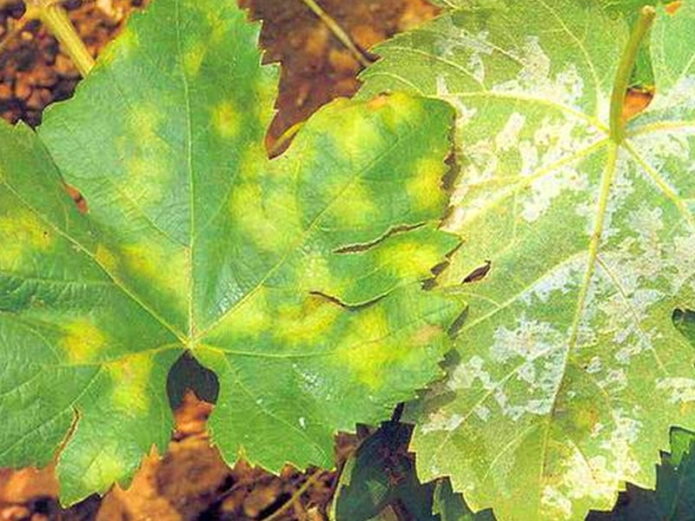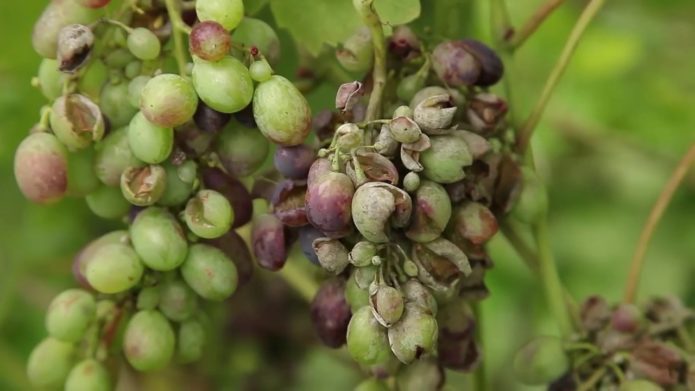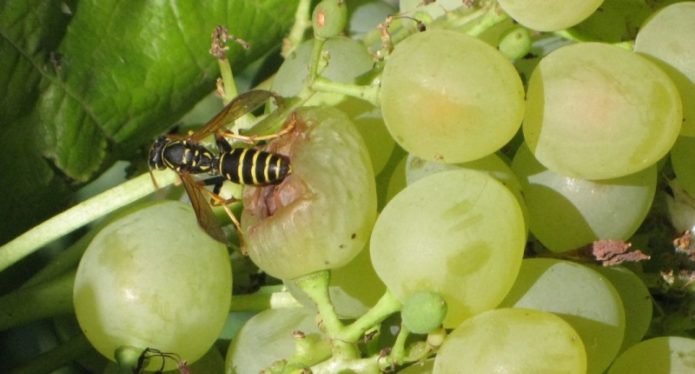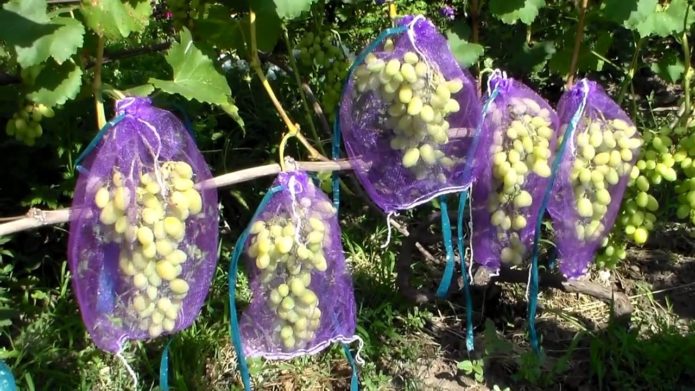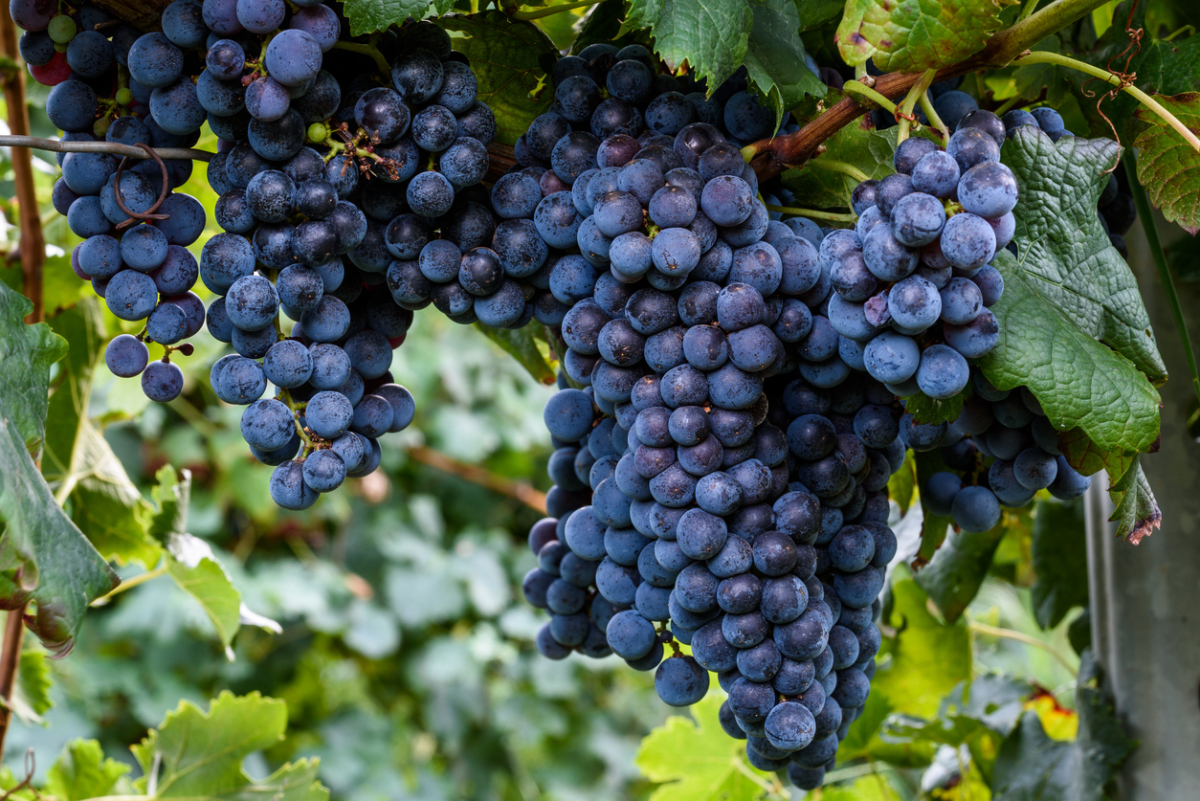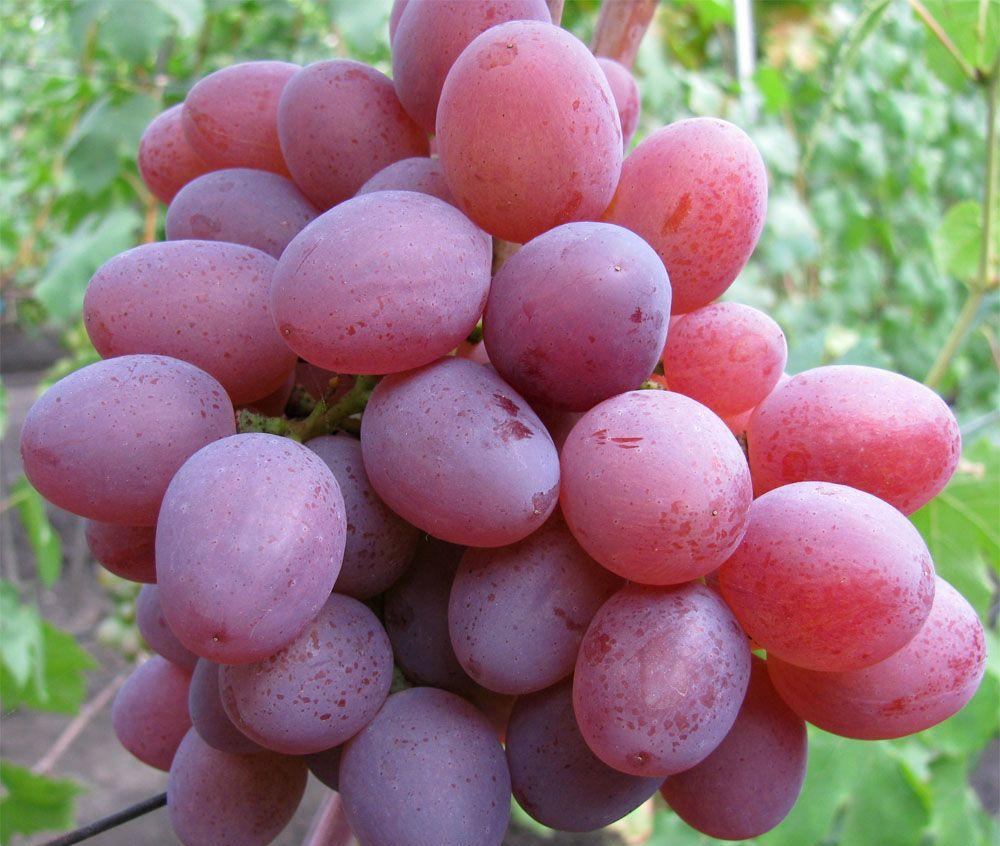Growing grapes is a difficult task. But more and more gardeners are gradually becoming interested in it, because new varieties are constantly appearing - with improved taste, cold-resistant, not so demanding to care for. For a beginner, Laura grapes are great, combining yield and excellent taste with relative simplicity to the cultivation conditions. The plant will "forgive" the gardener for individual care errors. But Laura is also appreciated by experienced winegrowers. In the post-Soviet space, it confidently ranks among the five best and most popular summer varieties.
Content
Description of Laura grapes
Laura grapes were bred in the 90s of the last century in Odessa. The process was quite complicated, time-tested varieties of culture were used - Queen Tairovskaya, Muscat de Saint-Valier, Husayne, Muscat Hamburg, Kober. From the latter, in particular, Laura inherited resistance to phylloxera, a real scourge of vineyards, and from the former, early maturity. In 2007, Laura was officially renamed Flora. It is under this name that it is now listed in the Ukrainian State Register of Breeding Achievements. But hobby gardeners still prefer the older, more familiar name.
Lora belongs to the category of early grape varieties. On average, the crop ripens in 110-115 days. But this period varies depending on the age of the vine and the load on it. The more bunches remain on the plant (the maximum that Laura can "stretch" is 50 brushes), the longer they mature. And vice versa, if the vine has less than 20 bunches, the berries ripen already in the first decade of August. The optimal load on an adult plant is 23–27 brushes.
Very little stress on Laura's vine is undesirable. In this case, the bunches ripen too quickly, and by the fall new ovaries may begin to form, which in no case should be allowed if you want the plant to properly prepare for winter.
The first berries can be tried two years after grafting or planting seedlings in the ground. Fruiting on the plant is slightly less than 80% of the shoots. For grapes, this is just an excellent indicator. Laura's flowers are unisexual, female. Pollination is carried out manually or a grape variety with male flowers is planted next to it. Good options are Arcadia, Rusbol, Radiant Kishmish. One plant is enough for 5-6 "female" vines.
All grape varieties are divided into canteen and technical, but the group of raisins stands apart, which are ideal for making raisins: they have absolutely or almost no seeds at all. One of these varieties is Rusbol grapes:https://flowers.bigbadmole.com/en/yagody/vinograd/vinograd-rusbol-opisanie-sorta-foto-otzyivyi.html
Laura does not differ in vigorous growth, but over time forms quite powerful vines. Therefore, she needs a medium or short cut. Young shoots are very thin, flexible, adults also retain this quality. The vines are quite easy to remove from the trellis and bend to the ground when you need to cover them for the winter. The bark on annual branches is terracotta; as it grows, it changes its shade to gray and begins to peel off strongly. You shouldn't worry about this. For this variety, this is the norm, and not some kind of exotic disease.
The leaves are rather large, five-lobed, of a beautiful dense green shade, smooth to the touch. Along the edge, the leaf plate is carved with small teeth.
Clusters of Laura grapes are large, dense, almost regular conical shape. The minimum bunch weight is 0.7–0.8 kg, the average length is 35–40 cm. But 2–3 kg for this variety is not the limit, if the grower takes good care of the plant and is lucky with the summer weather. The average yield is 26-30 kg from an adult vine at the age of 4-5 years. In particularly favorable seasons in terms of weather, this figure reaches 40 kg.
The berries are barrel-shaped, weigh 6–12 g each, and reach 3 cm in length. Very small ones are almost never found, Laura is not inclined to "pea". The skin of a pale salad shade is covered with a thin layer of bluish waxy coating. On the side of the berry that is facing the sun, there is often a “tan” of various tones - from pale golden to amber.
The taste qualities of berries are praised not only by amateur winegrowers, but also by professional tasters. From the latter, Laura earned a very high mark - 4.8 points out of five possible. The flesh of this grape is juicy, dense, almost crunchy, with a slight nutmeg aroma and the same aftertaste. Each berry contains 2-3 large seeds. The sugar content of grapes is very high - more than 20%. At the same time, the taste is not sugary, there is also a slight refreshing acidity (5–8 g per liter of juice). Berries can be simply eaten and used as a filling for baking, raw material for making raisins. Homemade wines made from these grapes are also very good.
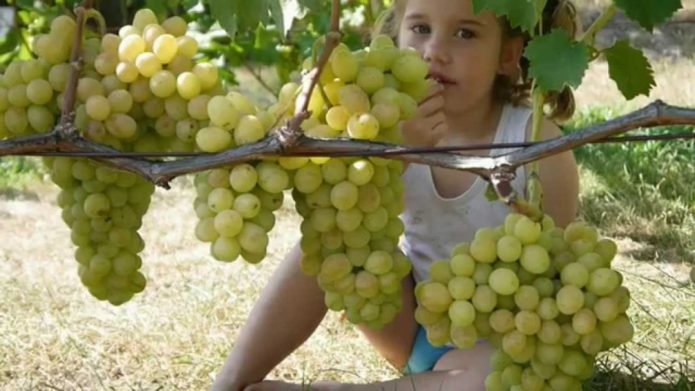
The taste of Laura grapes is simply wonderful, this is confirmed by the main connoisseurs - children
The peel of the berries is thin, but Laura tolerates transportation well, keeps well. Even ripe grapes do not crumble, they stay securely on the clusters. Another undoubted advantage is resistance to gray and white rot.
The frost resistance of this grape variety is up to -21-23ºС. At home, Laura successfully winters without shelter. But practice shows that if you properly protect it from frost, the vine can successfully endure much more severe winters, typical for regions with a temperate climate.
Laura has practically no flaws. The size of the berries decreases slightly, they become not so sweet if it rains in summer and the weather is cool. Of the diseases typical of the culture, it most often suffers from mildew and oidium. And the gardener will have to seriously fight for the harvest with wasps and birds. Inherent in the variety and a certain "instability". Most of the seasons are extremely successful in terms of harvest, but then suddenly a very bad year happens, when Laura suffers from both crumbling berries and sunburn, the bunches become "loose".
Laura responds very positively to regular treatments with Giberellin. It is a special phytohormone, a growth biostimulator that increases yields. The solution is sprayed with blossoming flowers, and ripening clusters are dipped into it. The size of the berries increases significantly, but the seeds decrease and become softer.
Arcadia is a unique grape variety: dozens of new developments appear every year, and he, a native of Soviet times, is still among the top ten grape varieties of the world assortment:https://flowers.bigbadmole.com/en/yagody/vinograd/vinograd-arkadiya-opisanie-sorta-foto-otzyivyi.html
Video: description and characteristics of grapes Laura (Flora)
Planting plants in the ground and preparing for it
Laura is quite unpretentious in her care, but obtaining bountiful harvests is impossible, if you do not take into account the "requirements" of grapes to the quality of the soil and other growing conditions. It develops best in fertile, but rocky soil, which is good for water and air.
This culture will definitely not grow on clay and saline substrates. The close location of groundwater is also undesirable (less than 2 m to the soil surface). The selected area should be open, well-warmed by the sun. The optimal place for placing a vineyard is a slope of a gentle hill, oriented in the south-east or south-west direction. But any lowlands do not fit categorically - it is colder than on a hill, there is less sun, rain and melt water lasts longer, damp air accumulates.
It is good if at some distance from the vine there is some kind of barrier that covers the plant from cold drafts, without shading it. A stone or brick wall of a house, a fence, moreover, warming up during the day, gives the accumulated heat to the vine at night.
At home, Laura can be planted both in spring and autumn. Everything is decided by the personal preferences of the gardener. But in regions with a temperate climate, the first option is much preferable. Over the summer, the plant will have time to take root in a new place, form a developed root system and accumulate enough nutrients for wintering. Landing in the fall is a big risk. Winter in these regions does not always come in accordance with the calendar, frosts can hit quite unexpectedly. And the plant after planting in the ground takes at least two months to adapt.
At the time of planting, the soil at a depth of about 15 cm should warm up to at least 10 ° C, and the air temperature should settle at 16-18 ° C. To speed up the heating process, sprinkle the soil with sifted wood ash or tighten it with plastic wrap. Laura's vines do not grow quickly, but strongly. When two or more seedlings are planted simultaneously, 1.5–2 m are left between them, and 2.5–3 m between planting rows. In most regions, planting is planned for the second half of May or the first decade of June, but if the climate permits, the dates can be shifted to the end of April.
It is necessary to provide a place for the trellis. Its height is not less than 2 m. It is a strong wire stretched horizontally in three rows between the supports. The bottom row is at a height of 40-50 cm, the second is 90-120 cm, the third is 160-180 cm. To prevent the vines from fraying, the grapes are tied to a support, placing a washcloth or a soft cloth. This should be done very carefully with Laura. Young shoots of this variety are extremely fragile.
How to tie up grapes on a trellis in spring:https://flowers.bigbadmole.com/en/yagody/vinograd/kak-podvyazyvat-vinograd-vesnoy.html
The root system of any grape is powerful, so the depth of the planting pit cannot be less than 80 cm. The diameter is about 60–70 cm. The best substrate for growing a crop is black soil, but if all the necessary fertilizers are applied, Laura successfully takes root and bears fruit in almost any soil ... You just need to remember that the lighter the soil, the faster it dries out and the more it freezes, and adjust the care accordingly.
They dig a landing hole in the fall. Expanded clay, pebbles, crushed stone, and small ceramic shards are poured onto the bottom in a layer not less than 8–10 cm thick. You can use other materials as drainage.Then they create a kind of “layer cake”, alternating humus with fertile soil mixed with fertilizers. Be sure to add simple superphosphate (120-150 g), potassium sulfate (80-100 g) and dolomite flour (200-250 g). Mineral fertilizers can be replaced with a liter can of wood ash. In total, there should be five layers, each about 10 cm thick. The soil is well spilled with water, a piece of a hollow tube of small diameter and such length is stuck into the bottom (closer to the edge of the pit) so that it protrudes to the surface by 8-12 cm. ...
The choice of planting material is no less important. Two-year-old grape seedlings take root best of all. The height of such a plant should be at least 50 cm. Several lateral shoots are required. The bark of healthy seedlings is smooth, without cracks, wrinkles and peeling, mold and rot spots, evenly colored in a reddish-brown color. The roots reach a length of 15 cm, they are white or creamy, elastic when cut. Young shoots and leaves (if any) are colored deep green. A pale salad shade indicates that the seedlings "lived" only in the greenhouse, such specimens do not differ in frost resistance. At the base of the trunk, there should be a slight "influx" - the place of inoculation. Its absence means that the seedling is grown from seed. Finding out exactly what the berries will be can only be experienced.
Of course, purchases are made only from trusted suppliers with a good reputation. From hands or at a fair, there is a high probability of purchasing low quality planting material. It is not a fact that it will be grapes, but there is nothing to say about the desired variety. It's good if the nursery where the seedlings are grown is nearby. Such plants are better adapted to the specifics of the local climate.
It is advisable to plant the purchased seedling as soon as possible. If it was purchased in the fall, it is dug into wet peat or sand for the winter. Until the moment of disembarkation, he should not "wake up" (growth buds did not begin to swell).
Disembarkation is carried out according to the following algorithm:
- For 12-14 hours, the roots are soaked in cool water. Some gardeners advise adding a biostimulant to it, others, on the contrary, do not recommend this, claiming that this substance will have a negative effect on the formation of the vine in the future.
- After this time, the seedling is cut shortly, leaving 3-4 growth buds ("eyes"). Of the available lateral shoots, only two are left. The roots in the upper "node" are cut off completely, the lower ones are shortened by a couple of centimeters. To prevent the development of fungal diseases, they are kept in a solution of any fungicide (DNOC, Baktofit, Ridomil-Gold) for a quarter of an hour.
- A little fertile soil is poured onto the bottom of the planting pit, forming a low mound. This is necessary to prevent the roots from getting "burned" from fertilizers. The seedling is placed on it, giving the desired position to the roots sticking up and to the sides. Plants with a closed root system are removed from the container along with an earthen lump, which is placed in a depression of a suitable diameter made in the substrate at the bottom of the planting pit.
- The pit is gradually filled with the substrate, periodically gently shaking the plant and compacting the soil so that no voids remain. The root collar, when the hole is filled up, should be 5–8 cm above the soil surface.
- Then the soil is trampled down. The grapes are watered using 20–30 liters of heated water per seedling. After about half an hour, it will be absorbed, and it will be possible to mulch the near-trunk circle with humus, peat chips, and freshly cut grass. Another option is to tighten it with any black covering material.

Planting grapes in the ground differs little from a similar procedure for other fruit trees and berry bushes
Video: the procedure for planting grape seedlings in the ground
Nuances of culture care
Throwing Laura's vine completely unattended and hoping for a bountiful harvest is at least naive. But nothing supernatural from the gardener is required. You just need to first familiarize yourself with the nuances of caring for a crop, because inept actions can cause a plant more harm than good.
Watering
The roots of any grape are powerful, going into the soil at least 5-6 m. Thanks to this, the vines tolerate even prolonged drought well, drawing water and nutrients from the soil. But this does not mean that the grapes should not be watered at all. With a moisture deficit, the berries become smaller, shriveled. The root system begins to actively develop in breadth and can "stifle" crops located within a radius of 3-4 m from the vine.
Young plants up to three years old are especially demanding on soil moisture. They are watered more often, about once a week, using about 30 liters of water per vine. For adult specimens, the rate is doubled, while the intervals between procedures are extended to 12-15 days. On sandy soils, water consumption is increased by another 1.5 times. About a month before the expected harvest, watering is stopped altogether so that the berries become sweeter, juicier and do not crack.
Watering intervals are adjusted depending on the weather. If the soil at a depth of about 0.5 m has dried out (it cannot be compressed into a lump), it's time for the next procedure. The best time to water is in the evening after sunset.
Watering grapes in the first season after planting in the ground, biostimulants (Epin, Kornevin, Zircon, Heteroauxin) can be added to the water, observing the dosage recommended by the manufacturer.
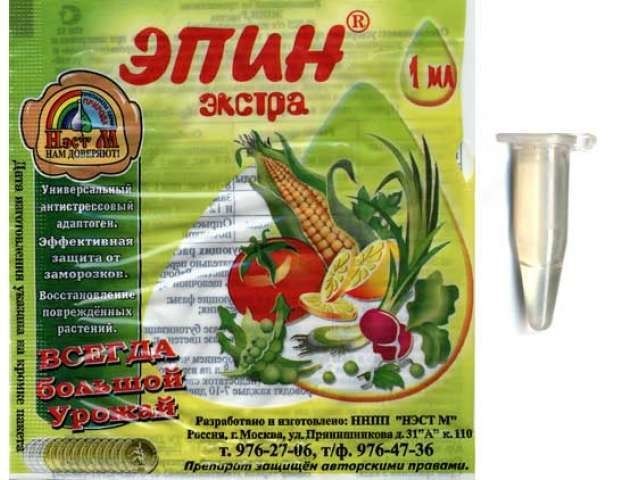
Epin, like any biostimulant added to the water for irrigation, has a positive effect on the immunity of the plant, contributes to its normal development
It is especially important to regularly moisten the soil at the time when leaf buds are blooming, after flowering, as well as at the time of the formation of fruit ovaries. During the flowering process, the grapes are not watered, otherwise the buds crumble strongly, respectively, the number of berries in the clusters decreases.
Drops of water, often falling on the leaves, can provoke the development of fungal diseases. Therefore, sprinkling as a method of watering grapes is strongly discouraged. Watering from a bucket or watering can does not allow the substrate to be wetted to the required depth. Water is poured either into tubes stuck into the bottom of the planting pit in advance, or into grooves between plants. Experienced gardeners even recommend building a canopy over the vines if the summer is rainy.
The first time Laura is watered in mid-April. If frost is still expected, it is better to use cold water - it will slow down the "awakening" of the kidneys, thus saving them from the effects of low temperatures. Conversely, warm water helps the vine "wake up" faster and start growing.
The last watering, water charging, is carried out in the middle of autumn. It helps plants to prepare properly for winter. But if aAugust and September were rainy, you can do without it. The norm for an adult vine is 70–80 liters.
Fertilization
Laura grapes get the bulk of their nutrients from the soil. Accordingly, most of the root feeding is carried out. Of the nutrients grapes need:
- Nitrogen. In the spring it is necessary for the vine to "wake up" and actively start growing. Starting from mid-June, the need for this macronutrient decreases. It is even harmful, because the rapid growth of shoots is at the expense of the formation of brushes. In addition, excess nitrogen in the soil negatively affects the plant's immunity.
- Phosphorus. Grapes especially need it at the beginning of flowering. Buds develop better, ovaries form faster.
- Potassium. It is introduced starting from the middle of summer, accelerates the ripening of berries.Also necessary for normal preparation for wintering.
- Copper. It has a positive effect on cold and drought resistance, stimulates the active growth of shoots.
- Bor. The berries ripen faster and become sweeter. The amount of pollen increases.
- Zinc. The yield increases markedly.
Grapes strongly deplete the soil, therefore, in addition to micro and macro elements, it needs humus to make the soil more fertile. It is applied every spring in the process of loosening the soil at the rate of 40-50 liters per adult plant. You can instead water the vines with an infusion of fresh cow dung or bird droppings diluted with water 1:10 and 1:15, respectively.
The first feeding is carried out in mid-April. The grapes are watered with a solution of Nitrofoski, Azofoski, Diammofoski, diluting 35–40 g of fertilizer in 10 liters of water. The procedure is repeated 10-12 days before flowering.
Phosphorus is added immediately before and immediately after flowering. 40-50 g of simple superphosphate are diluted in 10 liters of water. Or the same amount of fertilizer is distributed under the vines in a dry form, pouring it into annular grooves located 50–60 cm from the base of the stem. When the berries reach the size of peas, add potassium (20-30 g per 10 liters of water).
Further, during the summer, Laura grapes are fed at intervals of 15-18 days, using infusions of greenery of any weeds or sifted wood ash. This variety is very responsive to natural organic fertilizers. Special store preparations are also suitable - Novofert, Aquarin, Florovit, Clean Sheet.
They can also be used for foliar dressing. Or, the nutrient solution is prepared independently by diluting 1-2 g of potassium permanganate, zinc sulfate, copper sulfate, boric acid, and ammonium molybdate in a liter of water. For spraying, choose the evening of a cool, windless day. To make the solution better absorbed, add 30-40 g of sugar per liter.
The last time Laura grapes are fed in the second half of September, about a month after harvest. Use complex phosphorus-potassium fertilizers (ABA, Autumn) or a mixture of simple superphosphate and potassium sulfate (30–40 g per 10 l). Simple wood ash will work as well. It will take about 2 liters.
Video: typical mistakes of a beginner winegrower
Pruning
Laura is pruned so that there are 40-50 "eyes" on an adult vine. Most often, short pruning is carried out, by 2-4 "eyes". Practice shows that in this case the grapes bear fruit best.
Most of the pruning work is done in the fall. Doing this in the spring is very undesirable. "Wounds" on grapes are characterized by abundant sap flow, which often makes the growth buds soaked and start to rot. In this case, the vine can be severely damaged and even die. Therefore, in the spring they get rid of only those that have broken under the weight of snow and frozen branches.
In summer, it is also better not to disturb the grapes. At that time, only shoots affected by diseases and pests are removed. You also need to cut off the leaves that shade the bunches.
Autumn grape pruning correctly to carry out after the plant has completely lost its foliage and "went into hibernation", but always at a positive temperature. Unlike other fruit trees and berry bushes, unnecessary shoots are cut, leaving "hemp" 2-3 cm high. The "wounds" inflicted on the grapes do not heal, they can only dry out. The cuts are made so that they "look" inside the bush, and not outward, in one continuous motion, without "crumbling" the wood.
The vine takes 3-4 years to form. In the first year, the two most powerful and developed shoots are left, tying them to a support and directing them horizontally.The next season, their number is brought to four. The maximum number of fruiting shoots is eight.
On adult plants, first of all, it is necessary to remove weak and deformed shoots, "tops", all the growth on the lower part of the trunk to the first level of the trellis. The shoots tied to the second wire are shortened by about 10% and all side stepsons are cut off.
Then, at the height of the first and second levels, two shoots are selected, located on opposite sides of the trunk. One growing outward is cut short, leaving 3-4 growth buds. It is called a replacement knot. From the second bud, a new fruiting shoot will form on it for the next season. On the second (fruit arrow) 5-12 "eyes" are left.
Video: guidelines for pruning grapes
Preparing for winter
Laura's frost resistance is good, but not too high. It is enough for Ukraine and Russian regions with a subtropical climate. In all other areas, grapes will need shelter for the winter.
The first thing to do is to clear the tree trunk circle of plant debris and loosen the soil to a depth of 10–12 cm. Then the soil at the base of the trunk is dug up and all thin roots located close to the surface are cut off (the so-called katarovka). The soil is mulched with peat or humus, filling a layer about 10 cm thick. At the base of the trunk, it is increased to 25–30 cm.
The vines are carefully detached from the support. Laura has them quite flexible, so there shouldn't be any difficulties with this. Shoots are tied in 2-3 pieces, laid on the ground, sprinkled with fallen leaves, dry grass, wood chips, spruce branches. It is undesirable to use straw - mice can settle in it. If necessary, the vines are "pinned" to the ground.
Then the shoots are covered with several layers of burlap, agril, lutrasil, and other breathable covering material. As soon as a sufficient amount of snow falls, a snowdrift is poured over the vines. During the winter, it is refreshed 2-3 times, at the same time breaking the hard crust of the infusion on the surface.
In preparation for winter, plants and soil must be sprayed with 2% Bordeaux liquid or copper sulfate. This is necessary for the prevention of fungal diseases, mainly mildew and oidium.
In spring, grapes are opened no earlier than the air warms up to 8–10 ° C. If recurrent frosts are still possible, first, several holes can be made in the covering material.
Video: the procedure for preparing the vine for winter
Diseases, pests and control of them
The immunity of Laura grapes is not bad, but this does not mean that the defeat of pathogenic fungi is completely excluded. Practice shows that plants that are properly looked after are much less likely to suffer from them. Specific grape diseases are mildew and oidium. To the first, Laura has a fairly good resistance, the second is often affected.
The first signs of mildew are dark green, as if “oily” spots on the front side of the leaf and an almost imperceptible layer of whitish bloom on the inside. Similar symptoms are noted on buds and young fruit ovaries. Then they become covered with vague yellowish spots of various shapes. The affected tissues die off, holes are formed. The plant greatly inhibits its development, the yield drops sharply, the taste and appearance of the berries deteriorates. On ripe fruits, the disease manifests itself in the form of dark depressed spots next to the peduncle. Gradually the grapes turn black and crumble.
For prophylaxis, the grapes and the soil under it at the time of leafing and immediately before flowering are sprayed with any fungicides. The products proven by generations of gardeners are copper sulfate and Bordeaux liquid.There are also more modern drugs, including those of biological origin - HOM, Baikal-EM, Kuprozan, Bayleton, Skor, Strobi. In the fall, the soil is spilled with a solution of DNOC or Nitrafen. If suspicious signs are found, Ridomil-Gold, Horus, Topaz are used. 3-4 treatments are carried out with an interval of 10-12 days.
There are also folk remedies for the prevention of mildew. The grapes are sprayed with a bright pink solution of potassium permanganate, kefir diluted with water or whey with the addition of iodine (drop per liter). The vines are powdered with sifted wood ash, the soil in the garden - with crushed chalk. The base of the stem is tied with copper wire.
The first sign of powdery mildew is yellowish spots that are rapidly increasing in size, gradually covering up with a layer of gray-white bloom. The edges of the affected leaves rise up, they turn into something like a basket. The berries are covered with dark "ulcers" and burst. As the disease develops, the leaves fall off, the shoots dry up and die off.
For prophylaxis, plants and soil are treated with a solution of colloidal sulfur. The first time the procedure is carried out at the time of leaf bud opening, then 2-3 more times with an interval of 7-10 days. In the fall, before sheltering for the winter, the soil is sprayed with a 3% solution of ferrous sulfate. To combat the pathogenic fungus, the drugs Quadris, Antracol, Plantofol, Tiovit-Jet are used.
Pests attack Laura grapes relatively rarely. Wasps are the main danger for the future harvest. They feed on berry juice, damaged fruits rot.
The first thing to do is to find and destroy wasp nests on the site. A good effect in the fight against them is given by special pheromone or homemade traps. Deep containers are filled with honey diluted with water, sugar syrup, jam, puree from the pulp of slightly rotten fruits. To scare them away from plants, rags soaked in kerosene or turpentine are laid out in the aisles.
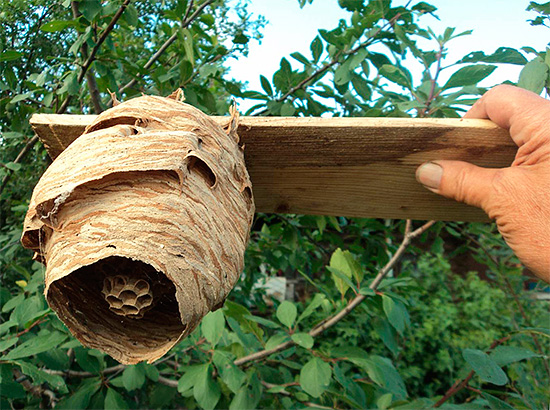
All wasp nests on the site must be found and destroyed, without this, the fight against insects will not give any effect
A folk remedy for fighting wasps is a homemade "nest" that is placed near the vineyard. It kind of signals to other wasps that "the place is occupied", and they fly around the site. It is also noticed that these insects do not tolerate the smell of lemon, cloves, red pepper.
On ripening brushes, put on bags of mesh fine-mesh fabric. Likewise, the crop is protected from birds. Or, you can net the whole vines over the net.
Gardeners reviews
Laura grape. Flowering begins on May 29. The results are excellent, I would say, even too much. Individual clusters are very dense. No peeling was observed. In the fourth year, Laura did show her face. Beauty! High yield (28-30 kg per bush). Huge bunches of a gorgeous look (up to 2.8 kg and up to 40 cm long). Berry 7-10 g, and separate and larger. She is not afraid of sunburn, and a tan suits her face. Add to this good taste and high transportability. In general, not a sort, but a miracle. But the stability is lame. There are years when Laura is peas, and hard enough. Very sensitive to overload. Disease resistance at the Arcadia level. Ripe wasps do not fly past. An excellent variety for the market and for yourself. Was cut from 10 to 15 August.
Laura is just a super variety! A hard worker variety. Probably one of the best varieties of our time, both in terms of berry quality and stability. The only sin is weak. I tried to graft it on a vigorous stock - the berry became larger and the brush was larger. Conclusion - requires a vigorous stock. It ripened late this year, around 20-22 August, the first brushes were removed. I will not be mistaken in saying that she is the best of the summer grape varieties.Each self-rooted bush yields about 30 kg of very good quality sweet grapes. It is pollinated perfectly, the brushes are calibrated, the taste is very good, even a little sweet for me.
This year I had the first fruiting of the Laura variety. The grapes are delicious and attractive.
Yes, Laura has a disadvantage - she is weak. They grafted it onto a vigorous stock - everything would be fine, but it slightly changed the shape of the berry and a little taste. The berry has become much larger and the brush is larger - it just flew away on the market! And I like the rooted one more ...
Laura! Flora! Very good grapes. I think that every site should be. Ukrainian table grape form with a functionally female flower, well pollinated. It is advisable to plant in a group with bisexual flowers. The pulp is tasty, dense. Very flexible in care, forgiving blemishes in care.
If they told me that I can keep one grape for myself, I would choose Laura. And I'm not ashamed of it. The bush was planted in spring 2006. The first fruiting of the bush in 2007 - 7.5 kg. Second fruiting in 2008 - 26 kg, all clusters around 1 kg.
The Laura variety appeared in our vineyard a long time ago and has served faithfully to this day. True, at first he worked for berries and for planting material, and now as rootstock bushes. The grapes themselves deserve attention: early ripening (around August 10), a large marketable berry with a firm sweet pulp. But there is still one problem: I'm tired of peas or over-pollination of bunches. It is very difficult to adapt to her whims and it is not entirely possible to predict, that is why she parted with these grapes without regret. I don’t know how anyone had it, but in our area with high humidity, Laura was always the first to catch mildew.
I have Laura more than other varieties damaged by wasps. It's a shame when a large, beautiful bunch turns into rot in 1–2 days. Tired of fighting, thinking about re-vaccination.
Laura did not disappoint this year, she ripened early, the berries were very long and beautiful. The bunches are large. We were satisfied.
Laura grapes are somewhat similar to Kesha grapes. But a little better in taste. This variety is not as afraid of frost as other elite grape varieties. Of course, it is better to warm for the winter. The variety is prolific. We collect a good harvest from the vine. The market understands it very well.
Laura is a vaunted variety, I admit it. But I had to see peas on it, and spots from sunburn. On the other hand, in some years it is just beautiful.
Laura has been bearing fruit for six years. She never had peas, burns. Maybe she was just lucky. The only and very unpleasant drawback is very fragile young shoots. Until you tie, you will swear. But now I just leave the eyes with a margin. And my customers really like her taste, they will try some Pink Timur and return to Laura with a request: "You give us this."
Laura grapes are relatively unpretentious to care for. But if you first familiarize yourself with the agricultural technology of growing it, he will thank the gardener with a good harvest. He successfully adapts to a temperate climate, subject to shelter for the winter without much damage to himself endures severe winters. The berries are distinguished by excellent taste and presentability. Laura's brushes are large, aligned, regular in shape. The variety received good immunity from the creators, so this grape relatively rarely suffers from diseases and pests. Laura has a lot of advantages, there are practically no shortcomings. Thanks to this, the variety is extremely popular both among those who are just starting to grow grapes and among professionals in this business.
